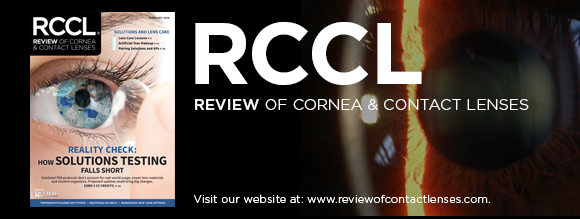Corneal Diameter Affects Postoperative Astigmatism
Corneal diameter should be determined prior to cataract surgery, as it can lead to varying degrees of corneal astigmatism depending on the type of incision used, reports a study in the January 2016 issue of Cornea. Other factors already known to impact postoperative astigmatism include incision size, configuration and location relative to the limbus, as well as the axis on which the main incision is performed. More
Lipid-binding Differences Noted
Deposition of cholesterol on contact lenses varies significantly between lens materials, reports a study in the January 2016 Optometry and Vision Science. Though silicone hydrogel (SH) materials are known to increase oxygen transport to the ocular surface, certain chemical components within these materials may also negatively impact wettability (and potentially patient comfort) if exposed to very high levels of lipids. To date, however, no study has investigated the degree to which daily disposable lenses uptake lipids—in particular, cholesterol. More
Chicken Pox Vaccine Linked to Keratitis
Researchers from the University of Missouri School of Medicine have identified a link between administration of the varicella zoster virus vaccine for chickenpox and shingles and presentation of keratitis. Though the potential for corneal inflammation as a side effect of the vaccine is low, primary care physicians should inform all patients prior to administration, the researchers say.
More
More Orthokeratology Focus Needed
Consider reinforcing orthokeratology education, particularly for male patients, reports a study in the January 2016 issue of Eye & Contact Lens. Researchers in southern Taiwan identified a total of 86 microbial strains from 38 culture-positive specimens taken from orthokeratology lens case fluids of 41 pediatric wearers. Interestingly, frequently reported pathogens (i.e., Serratia marcescens, Pseudomonas aeruginosa and Staphyloccocus aureus) in contact-lens related microbial keratitis were identified less commonly in this study; additionally, the lens cases of male subjects exhibited a higher microbial bioburden than those of female subjects. More
Surgical Procedure Comparison Suggests Benefits
A comparison of femtosecond laser-assisted LASIK and small-incision lenticule extraction (SMILE), published in the February 2016 issue of Cornea, suggests both procedures achieve similar good visual outcomes in the correction of myopia and myopic astigmatism; however, patients who underwent SMILE exhibited a lower induction rate of spherical aberration six months postoperatively, suggesting long-term outcomes of the procedure may ultimately be more beneficial. However, further research is needed based on a larger sample size to confirm this.
More
Lens Rinse Announced
Menicon America has announced FDA approval for its LacriPure non-preserved saline for rinsing both soft and rigid lenses. Packaged in 5ml unit-dose vials, the saline is also approved as a first-of-its-kind scleral lens insertion solution as an alternative to irrigation saline, according to Menicon.
More
SPEED Questionnaire Vetted
The Standard Patient Evaluation of Eye Dryness (SPEED) questionnaire is comparable to the Ocular Surface Disease Index (OSDI) questionnaire for separating asymptomatic and symptomatic dry eye patients, reports a study published in the February 2016 issue of Cornea. Investigators compared the answers of 657 undergraduate students at the University of Cape Coast in Ghana, determining the internal consistencies of the OSDI and SPEED questionnaires to be approximately the same (i.e., 0.897 and 0.895, respectively). However, the SPEED questionnaire was relatively better in terms of internal consistency compared with the OSDI questionnaire, indicating it is a valid measure for dry eye and could be used in epidemiological studies and clinical practice, the researchers say.
More
|
|
|
